acrn-zephyr-ehl¶
The following section is applicable to:

Important
Complete the pre-requisite section Setting up ECI Build before continuing further.
The ECI acrn-zephyr-ehl Yocto target image provides the ACRN Hypervisor, in logical mode, with Zephyr and base-poky as prelaunched VMs. Graphical User Interface (GUI) is not available with this build option. A serial console (COM port) interface is used to access ACRN, Zephyr and Linux-RT VM command prompts.
Important
ACRN is only supported on specific target platforms! Please see section Validated Hardware Platforms for a list of platforms which support ACRN. To build ACRN for non-supported platforms, see section Compiling ACRN for different platforms.
Run the setup script:
$ ./setup.sh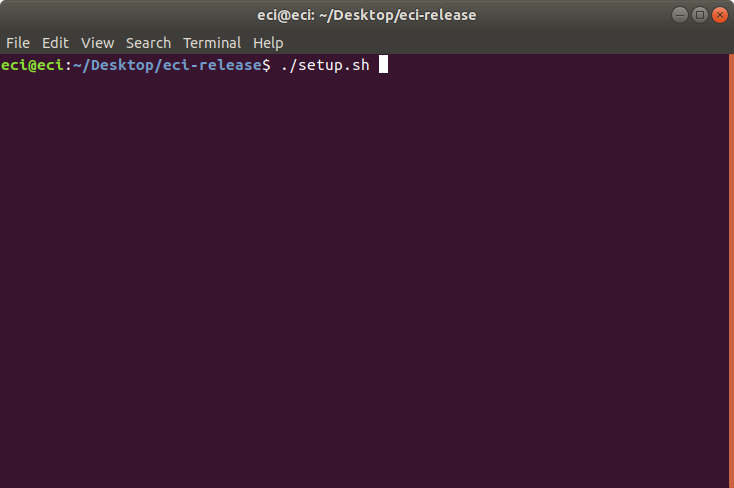
The setup script will present a list of pre-configured use cases. Select
customto start configuring a custom build.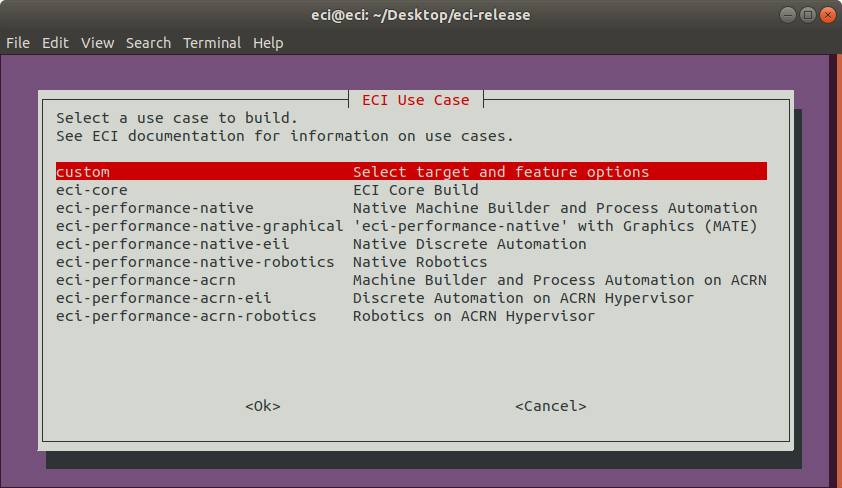
The setup script will present a list of available build targets. Select
acrn-zephyr-ehlfrom the list.
On the following prompt, it is possible to select available Zephyr samples in pre-launched Zephyr VM. Select/deselect sample image to be included in the image using the arrow keys to move the selection and spacebar to toggle the state. When complete, press the enter key to finalize the selection.
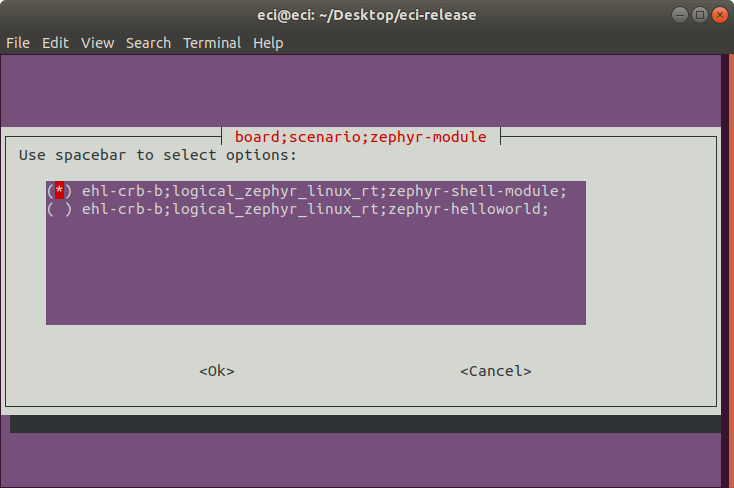
On the following prompt, it is possible to modify the build configuration of the pre-launched Linux RT image. Select/deselect features to be included in the image using the arrow keys to move the selection and spacebar to toggle the state. When complete, press the enter key to finalize the selection.
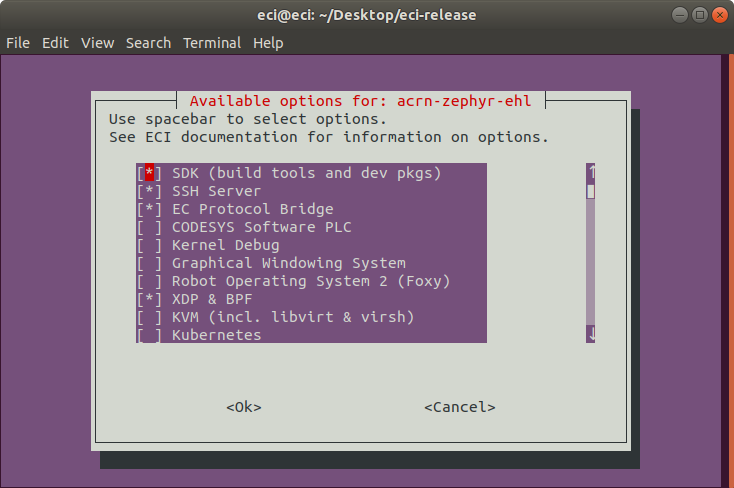
The following table describes the various options available:
Feature Option
Description
SDK (build tools and dev pkgs)
Adds GCC and Make to the target image.
SSH Server
Adds an SSH server to the target image.
EC Protocol Bridge
Edge Control Protocol Bridge bridges various industrial protocols together, effectively providing a translation from one protocol to another.
CODESYS Software PLC
CODESYS Software PLC provides a Linux runtime that allows control applications to execute on Linux-based systems. This feature requires a CODESYS .deb file to be added to the build environment.
Kernel Debug*
Enables Kernel debug capabilities on the target.
Graphical Windowing System*
Adds XFCE - a X11 based graphical window manager to the target image.
Robot Operating System 2 (Foxy)
Provides core essentials of ROS2 software
XDP & BPF
Allows packets to be reflected, filtered or redirected without traversing networking stack. Selecting this feature will add eBPF and XDP features to the target image.
KVM (incl. libvirt & virsh)
Adds KVM and virtualization tools such as libvirt and virsh to the target image.
Kubernetes
Adds binaries required to join a Kubernetes cluster.
Intel® Castle Lake Dependencies
Adds kernel modules and tools necessary to support an Intel® Castle Lake Client.
Intel® In-Band Manageability
Intel® In-band Manageability enables an administrator to perform critical Device Management operations over-the-air remotely from the cloud. Selecting this feature will add Intel In-Band Manageability software to the target image.
Intel® Time Coordinated Computing
Enables Intel® Time Coordinated Computing Tools (Intel® TCC Tools) features.
Attention
Intel TCC Tools features are only supported on 11th Gen Intel® Core™ and Intel Atom® x6000E Series processors.
Intel® EII
Enables Intel® Edge Insights for Industrial features.
Mender support
Adds support for Mender remote update: https://mender.io/
Kernel source
Adds kernel source & header files to the target image.
Time series processing
Enables Time-series processing features.
Security Enhanced Linux (SELinux)
Adds SELinux: https://github.com/SELinuxProject/selinux
Attention
SELinux support is not fully complete yet! Use this feature only as a reference.
*Experimental*
Enables experimental features.
Note
ACRN does not support Graphical Windowing System for prelaunch VMs.
The setup script will begin downloading and configuring the assets needed to build the target image. Depending on the feature options selected and state of the build environment, a few notifications may occur. Some of these notifications are described below.
If the setup script is not building the target for the first time, the script will prompt:
Build directory ecs-acrn-zephyr-ehl already exists. Do you want to clean the cached build? y/[n]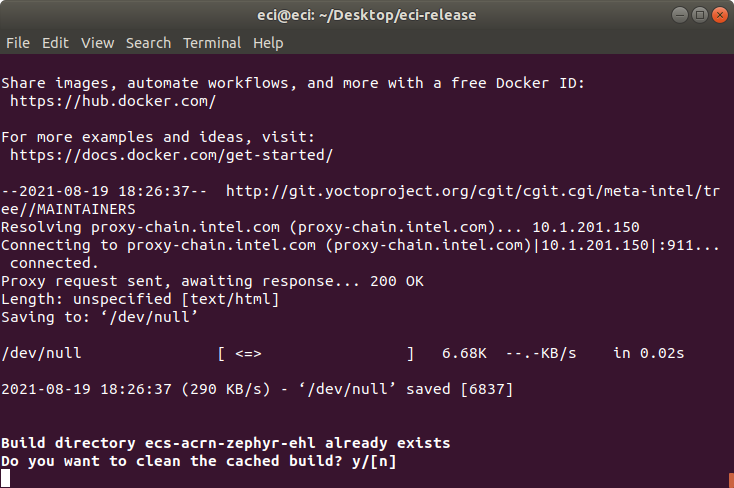
Press n to retain the target build cache, or press y to delete target build cache.
Note
It is advised to delete the target build cache if the target source was modified or the previous build was incomplete. Retaining the target build cache will reduce the build time, but may promote build errors if the target source was modified or the previous build was incomplete. If build errors occur, rerun the setup script and choose y at this prompt.
For all other notifications, refer to the section links below:
After setting up the build target, the script will prompt:
Do you want to run an automated build? y/[n].
To perform an automated build, press y at the prompt.

To perform a manual build, press n at the prompt. The setup script will output a completion message with the steps necessary to perform a build manually.
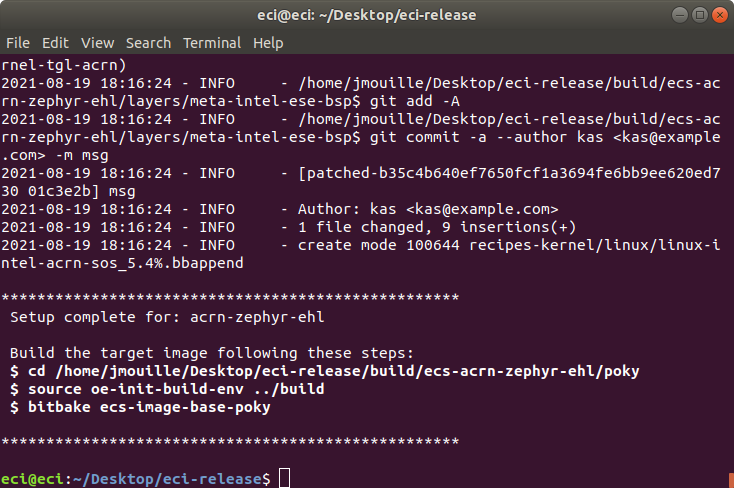
Perform the steps provided by the setup script. These steps will start the build process. For this example we performed:
$ cd /home/eci/Desktop/eci-release/build/ecs-acrn-zephyr-ehl/poky $ source oe-init-build-env ../build $ bitbake ecs-image-base-poky
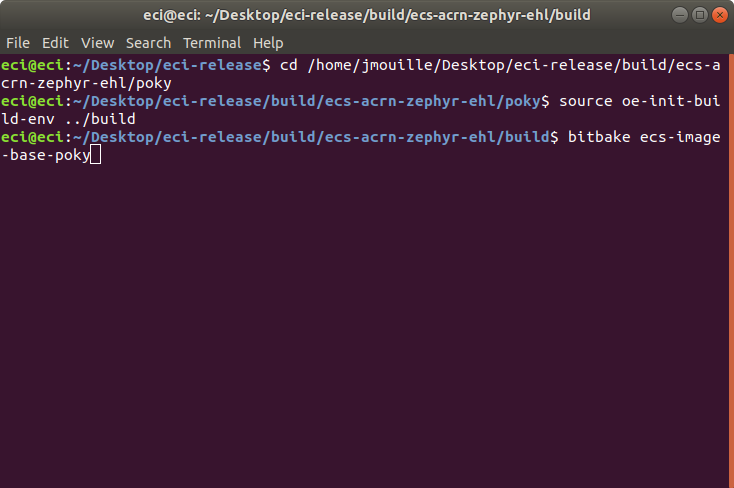
The build typically takes a very long time. A Linux build system with the recommended specs may take about 1-2 hours to complete. A Linux build system with the minimum specs may take 6+ hours to complete. See section Linux Build System for recommended specs.

Note
Final image consists of Zephyr and Linux launchable by ACRN in sbl_os container image format, bootable by sbl_os. User can point to a different signing key file by overwriting PREGENERATED_SIGNING_KEY_SLIMBOOT_KEY_SHA256 variable or by replacing the key file contents of /meta-acrn-tgr/meta-acrn-tgr-poky/cert/OS1_TestKey_Pub_RSA2048_priv.pem to match the one in Intel® Elkhart Lake Slim Bootloader (SBL) (Intel RDC#616714) used to build SBL and IFWI binary file. Refer to section Create Container Boot Image in Sbl_Ehl_ReleaseNotes.pdf (part of Intel® Elkhart Lake Slim Bootloader (SBL) (Intel RDC#616714)) for information regarding SBL bootable Container Boot Image format. Steps to generate signing keys is outside of the scope of this documentation.
After the build completes, see section Installing ECI-A to create a bootable USB flash drive to install the ECI-A image.